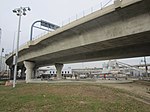Millers River (Middlesex)
AC with 0 elementsCambridge, MassachusettsFormer riversGeography of Middlesex County, MassachusettsRivers of Massachusetts ... and 3 more
Rivers of Middlesex County, MassachusettsSomerville, MassachusettsWatersheds of Boston Harbor

Millers River (frequently written as Miller's River) was a river in Middlesex County, Massachusetts. It has since mostly been obscured by landfill and "made land" (land created by filling of waterways). The small remaining estuary is a remnant of wetlands and open water that once divided Cambridge from Charlestown, Massachusetts. The exact historical course of parts the river is somewhat uncertain, and thus parts of the Charlestown-Cambridge and Somerville-Cambridge borders may have changed due to incorrect historical reconstruction.
Excerpt from the Wikipedia article Millers River (Middlesex) (License: CC BY-SA 3.0, Authors, Images).Millers River (Middlesex)
Miller's River Littoral Way, Boston Charlestown
Geographical coordinates (GPS) Address Nearby Places Show on map
Geographical coordinates (GPS)
| Latitude | Longitude |
|---|---|
| N 42.370555555556 ° | E -71.065638888889 ° |
Address
Miller's River Littoral Way
Miller's River Littoral Way
02222 Boston, Charlestown
Massachusetts, United States
Open on Google Maps










